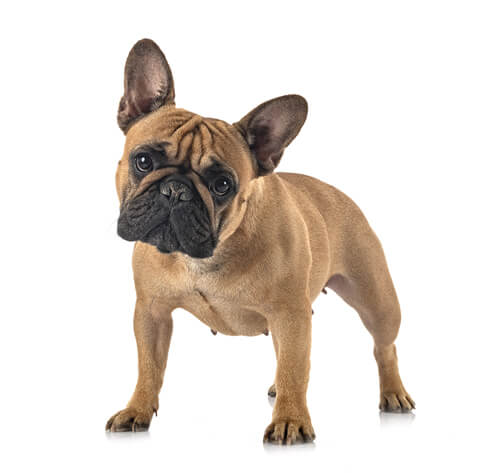
French Bulldog
The French Bulldog was developed by English lace makers who bred a toy-sized bulldog to be a lap pet. After the Industrial Revolution, this intelligent, well-behaved, playful breed became popular in France. Prized for his affectionate, even disposition, the French Bulldog is an active, alert watch dog that requires minimal exercise. His fine, smooth coat needs little maintenance.
DID YOU KNOW? The French Bulldog is a popular breed among Hollywood celebrities including Hugh Jackman, David Beckham and Reese Witherspoon.
ALSO KNOWN AS: Bouledogue Français
The need-to-know
- Dog suitable for non-experienced owners
- Basic training required
- Enjoys gentle walks
- Enjoys walking half an hour a day
- Small dog
- Minimum drool
- Requires grooming once a week
- Non hypoallergenic breed
- Quiet dog
- Guard dog. Barks and alerts
- May require training to live with other pets
- May require training to live with kids
Personality

This is a friendly, good-natured, playful dog, who makes an ideal affectionate and fun companion or family dog that’s as happy living in towns and cities as in the countryside. This is a courageous breed who think they are many times bigger than they actually are - and can on occasions find themselves in conflict with other dogs who can’t read their flat face and lack of tail.
A French Bulldog would suit an owner who lives in a smaller space and who doesn’t want to have to give their dog a lot of exercise but enjoys plenty of games and interaction in the home. They probably shouldn’t object to snoring either…
History and Origins

The French Bulldog is originally descended from the Toy Bulldog, a miniaturised version of the British Bulldog, and a breed that was popular with the lace-makers of Nottingham. During the industrial revolution, many relocated to France and took their dogs with them. Here the breed changed, possibly with the inclusion of other breeds including the Pug and some terriers, resulting in the French Bulldog we know and love today.
Nutrition and Feeding

Small dogs have a fast metabolism, meaning they burn energy at a high rate, although their small stomachs mean that they must eat little and often. Small-breed foods are specifically designed with appropriate levels of key nutrients and smaller kibble sizes to suit smaller mouths. This also encourages chewing and improves digestion.
Exercise

The Frenchie doesn't require very much exercise compared with some breeds and about an hour's exercise daily should suffice. Do ensure that they are protected from the heat, as due to their flat face they can suffer heat exhaustion and respiratory distress if exercised in warm weather. Exercise them in the early morning and late evening in the summer.
Other Information

Health and Common Issues
The most common health problems encountered in the French Bulldog relate to their flat face, which may result in obstruction of their airways and a difficulty in breathing. Over-exercising and over-heating is therefore to be avoided. They are also prone to skin infections, eye problems, hip and elbow dysplasia (joint conditions that can be painful and lead to mobility problems) and spinal disorders. Pet insurance is a must for this breed - as is buying from a reliable and knowledgeable breeder.
Space Requirements
The Frenchie doesn’t need a lot of space so is as happy living in a flat as in a house with a garden, as long as they have access to the outdoors for exercise and toileting.
Training French Bulldogs
The French Bulldog is never going to be an obedience champion or excel in your local training class, but with patience and reward-based training they can easily master the basic exercises like sit, down, recall and walking on a lead and harness. They can also enjoy interactive enrichment games.
Best Family Dog Breeds
The French Bulldog can happily fit into family life and gets on well with older children, although may not be a great fit for an active sporty family or a family with younger children. While many dogs are traditionally thought of as being good with children, all dogs and children need to be taught to get on with and respect each other, and be safe together. Even so, dogs and young children should never be left alone together and adults should supervise all interactions between them.
Did You Know?
- While starting off life as a working rural companion, stories of the French Bulldog’s unconventional appearance spread to Paris where they were adopted by those who wanted to appear socially daring and they found fame in paintings by Degas and Toulouse-Lautrec. Postcards can still sometime be found of scantily clad women posing with their ‘Bouledogues Francais’.
- In the majority of cases, French Bulldogs can’t swim because of their short snouts which cause their body to tilt backward to keep their nose and mouth above water and their large heads and short legs make it difficult for them to stay afloat.
- One unfortunate French Bulldog called Gamin de Pycombe was on the ill-fated Titanic when it sunk. He had been bought in England for the very high price of £150 (£13,500 in today’s money) and was insured for what at that time was an extraordinary amount of money -$750.
- A French Bulldog called Bugsy took care of a baby orangutan named Malone who was abandoned by his mother at Twycross Zoo.
- Despite not being barkers, they’re very talkative and will communicate with you in the form of yips, gargles and yawns!